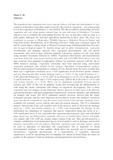Please use this identifier to cite or link to this item:
https://cris.library.msu.ac.zw//handle/11408/2850| Title: | Vegetation soil relationships as aids to soil survey in semi-arid areas | Authors: | Zhou, Neil Mandinyenya | Keywords: | Vegetation physiognomy Zimbabwe Land quality Soil nutrients |
Issue Date: | 2012 | Publisher: | University of Zimbabwe | Abstract: | The hypothesis that vegetation and woody species indicate soil type and land potential is very common in Zimbabwe and other similar countries. Research in vegetation – soil relationships to test this hypothesis in Zimbabwe is very limited. This thesis explores relationships between vegetation and soils along granite catenas found in semi arid areas of Zimbabwe. The main objective was to establish the relationship between the two, so that they could be used as a land quality indicators for increased agricultural production in these areas. The study was conducted on granite in Mushandike Wildlife Sanctuary, Makoholi Research Station and Gutu Soti-Source Resettlement, all in Masvingo Province within agro ecological region III and IV and in Maruta village found in Wedza Communal land of Mashonaland East Province also in agro ecological region III. Satellite image and air photo interpretations, vegetation classification and mapping together with vegetation measurements and soil profile assessments were used as data collection methods. Laboratory analyses of soils were done using standard procedures followed by AREX. Vegetation identification and measurements were done during the rainy season between November and April 1999. Plant species and soils data collected were prepared in appropriate formats for statistical analyses with the aid of SPSS statistical package. Vegetation community data were analysed using multivariate ordination techniques that include Cluster analysis, Detrended Correspondence Analysis (DCA) and Canonical Correspondence Analysis (CCA). Results from the study revealed that there was a significant correlation (at p < 0.05 significance level) between species richness and soil characteristics that include drainage status (r = -0.53); % clay in the B horizon (r = - 0.28); pH in the B horizon (r = -0.32); CEC in the B horizon (r = 0.37); Ca to Mg ratio in the A and B horizons (r = 0.85 and r = 0.45 respectively); ESP in the B horizon (r = 0.71) and soil erosion intensity (r = -0.45). There was no significant correlation between species richness and AWC of the soil. In addition, results also revealed that the differentiation of soils along the catena correspond with changes in vegetation physiognomy. Due to these vegetation and soil changes on the landscape, distinct patterns of land facets with different agricultural potential and land management requirements could be identified and delineated on imagery and maps. The DCA ordination analysis however showed that the major ecological gradients and the most important environmental factors that influence vegetation types and species composition along the catena were related to soil moisture, drainage status, available soil nutrients, excess sodium salts and soil erosion intensity. The CCA ordination analysis showed that of the soil variables used in the analysis, none of them except drainage status (p = 0.03) and erosion intensity (p = 0.01) were responsible for changes in the distribution and abundance of vegetation and species composition along the catena at p < 0.05 significance level. It was concluded that vegetation physiognomic types and individual plant species are not influenced by particular soil types or characteristics such as soil depth, clay content, pH, CEC, ESP and organic matter content of the soil. They are influenced by a complex combination of environmental factors or land qualities such as drainage, soil erosion intensity, soil fertility and soil sodicity. Therefore vegetation types and plant species cannot be used as indicators of individual soil characteristics but as indicators of broad environmental attributes or land qualities which affect site potential and its management. Nevertheless, vegetation physiognomy, as a characteristic of vegetation structural significance, could be a promising tool for mapping soil patterns in detail along the catena on granite for the purpose of land use planning and management in semi arid areas. | URI: | http://ir.uz.ac.zw/handle/10646/879 http://hdl.handle.net/11408/2850 |
| Appears in Collections: | Theses |
Files in This Item:
| File | Description | Size | Format | |
|---|---|---|---|---|
| Zhou N.pdf | Abstract | 115.6 kB | Adobe PDF |  View/Open |
Page view(s)
260
checked on Dec 7, 2025
Download(s)
86
checked on Dec 7, 2025
Google ScholarTM
Check
Items in MSUIR are protected by copyright, with all rights reserved, unless otherwise indicated.



